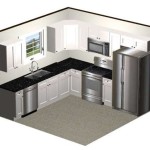Can You Stain Kitchen Cabinets? A Comprehensive Guide
Staining kitchen cabinets is a common and cost-effective method of updating the appearance of a kitchen without the expense of completely replacing the cabinetry. The viability of staining, however, depends on several factors, including the material of the cabinets, the existing finish, and the desired outcome. This article provides a detailed exploration of the feasibility of staining kitchen cabinets, covering the preparation process, staining techniques, and troubleshooting common issues.
The primary consideration is the material of the cabinets. Solid wood cabinets are the most receptive to staining. Wood's porous nature allows it to absorb the stain, enhancing the natural grain and adding depth of color. However, not all wood types stain equally well. Hardwoods like oak, maple, and cherry offer excellent results due to their pronounced grain patterns and ability to accept stain evenly. Softer woods like pine may require pre-stain wood conditioner to prevent blotchiness.
Cabinets made from medium-density fiberboard (MDF) or covered in laminate are generally not suitable for staining. MDF, while a stable and smooth material, lacks the natural grain structure necessary for stain absorption. Laminate surfaces are non-porous and specifically designed to resist liquids, including stains. Attempting to stain MDF or laminate will likely result in an uneven, unattractive finish.
The existing finish on the cabinets also plays a crucial role in determining the success of a staining project. If the cabinets are currently painted or varnished, the old finish must be completely removed to expose the bare wood underneath. This process typically involves chemical stripping, sanding, or a combination of both. The thoroughness of this preparation is paramount; any remnants of the old finish will prevent the stain from penetrating the wood properly, leading to an inconsistent and unsatisfactory result.
Even if the cabinets are made of solid wood and have a suitable existing finish, the desired color change must be considered. Staining can only darken or slightly alter the existing color of the wood. It cannot lighten the wood significantly. For example, attempting to stain dark oak cabinets a light gray color is not realistically achievable through staining alone. In such cases, painting is a more appropriate option.
Key Point 1: Assessing Cabinet Material and Existing Finish
The initial step in determining whether kitchen cabinets can be stained involves a thorough assessment of the cabinet material and the existing finish. As previously mentioned, solid wood cabinets are the best candidates for staining. Identifying the type of wood will help in selecting the appropriate stain and application techniques. Oak, maple, and cherry are commonly used in cabinet construction and respond well to staining. Pine, while stainable, requires extra care to avoid uneven absorption.
To determine the material, carefully examine the cabinet doors and frames. Solid wood will exhibit a discernible grain pattern that continues across the surface. MDF will have a smooth, consistent appearance with no visible grain. Laminate surfaces will typically feel smooth and non-porous to the touch.
The existing finish must also be evaluated. Painted cabinets will have an opaque coating that completely obscures the wood grain. Varnished cabinets will have a clear or tinted coating that allows the grain to be visible, but the wood surface will be sealed. If the cabinets have been previously stained, the existing stain may need to be removed or lightly sanded to improve adhesion of the new stain.
The key takeaway is that thorough preparation is essential. Skipping or skimping on this stage will almost certainly lead to problems later. Thoroughly cleaned, sanded, and prepped cabinets are vital for achieving a professional-looking stained finish.
Key Point 2: The Preparation Process: Stripping, Sanding, and Cleaning
Assuming that the cabinets are made of stainable material and the desired color change is feasible, the next step is preparing the cabinets for staining. This process involves several critical steps: removing the hardware, stripping the old finish (if necessary), sanding the wood surface, and cleaning away any dust or debris.
Begin by removing all hardware, including knobs, pulls, hinges, and any other decorative elements. This will prevent the hardware from being damaged during the stripping and sanding process and will ensure a clean, uniform finish on the cabinets.
If the cabinets are painted or varnished, the old finish must be removed. Chemical strippers are effective at dissolving the old finish, but they can be harsh and require proper ventilation and safety precautions. Apply the stripper according to the manufacturer's instructions, allowing it to soften the finish before scraping it away with a plastic scraper. Multiple applications may be necessary to completely remove stubborn finishes.
Sanding is essential for creating a smooth, even surface for the stain to adhere to. Start with a coarser grit sandpaper (e.g., 80-grit) to remove any remaining finish or imperfections. Gradually progress to finer grits (e.g., 120-grit, then 220-grit) to refine the surface and create a smooth, polished feel. Sand in the direction of the wood grain to avoid scratching or damaging the wood.
After sanding, thoroughly clean the cabinets to remove all dust and debris. Use a tack cloth or a damp cloth to wipe down the surfaces, ensuring that they are completely clean and dry before applying the stain. This step is critical for preventing the stain from being absorbed unevenly or creating a cloudy finish.
For woods like pine, applying a pre-stain wood conditioner before staining is helpful. Doing this helps to create a more uniform absorption of the stain, preventing blotchiness and ensuring a more even color distribution.
Key Point 3: Staining Techniques and Troubleshooting
Once the cabinets are properly prepared, the staining process can begin. Selecting the right stain color and type is essential. Oil-based stains offer excellent penetration and durability but require mineral spirits for cleanup. Water-based stains are lower in VOCs (volatile organic compounds) and clean up with water, but they may not penetrate as deeply as oil-based stains.
Always test the stain on an inconspicuous area of the cabinet or a scrap piece of wood before applying it to the entire surface. This will allow you to assess the color and application technique and make any necessary adjustments.
Apply the stain evenly using a brush, rag, or foam applicator. Work in the direction of the wood grain, and avoid applying too much stain at once. Allow the stain to penetrate the wood for the recommended amount of time (typically a few minutes), and then wipe away any excess stain with a clean cloth. The longer the stain remains on the wood, the darker the color will be.
For a deeper, richer color, apply multiple coats of stain. Allow each coat to dry completely before applying the next. Lightly sand between coats with fine-grit sandpaper (e.g., 320-grit) to smooth out any imperfections and improve adhesion.
After the stain has dried completely, apply a clear topcoat to protect the finish and enhance its durability. Polyurethane, varnish, and lacquer are common choices for topcoats. Apply several thin coats of topcoat, allowing each coat to dry completely before applying the next. Lightly sand between coats with fine-grit sandpaper to create a smooth, even finish.
Common staining problems include blotchiness, uneven color, and streaking. Blotchy staining can be prevented by using a pre-stain wood conditioner, as mentioned earlier. Uneven color can be caused by inconsistent application or inadequate surface preparation. Streaking can be caused by wiping away the stain in the wrong direction or using a dirty cloth.
If problems arise, carefully assess the situation and make adjustments to your technique. If the stain is too dark, try lightening it by wiping away more of the excess stain or by sanding the surface lightly. If the stain is too light, apply another coat. If the finish is uneven or streaky, lightly sand the surface and apply a fresh coat of stain.
Remember that patience and attention to detail are crucial for achieving a professional-looking stained cabinet finish. With proper preparation and technique, staining can be a rewarding and cost-effective way to update your kitchen.

Staining Kitchen Cabinets Pictures Ideas Tips From Hgtv

Staining Your Wood Cabinets Darker Young House Love

How To Stain Oak Cabinetry Tutorial The Kim Six Fix

How To Stain Wood Cabinets True Value

How To Make Rustic Kitchen Cabinets By Refinishing Them The Best Stain Color Amanda Katherine

How To Stain Dark Or Yellow Kitchen Cabinets Lighter

Painted Vs Stained Cabinets Jm Kitchen And Bath Design

The New Cabinet Stain Colour For Kitchens Trends Wood

15 Stunning Kitchens With Stained Cabinets Sincerely Marie Designs

Painted Vs Stained Cabinets Jm Kitchen And Bath Design








